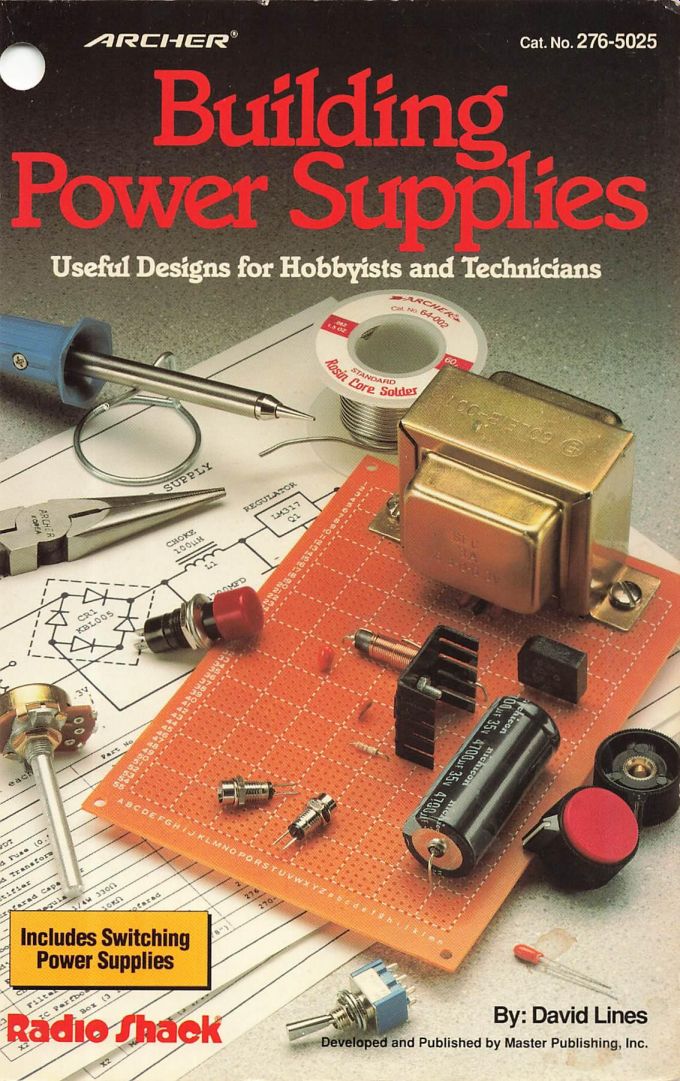
Table of Contents
PREFACE (this page, below)
SECTION 1 Basic SOURCES OF DC AND AC POWER
SECTION 2 UNREGULATED POWER SUPPLY SYSTEMS
SECTION 3 Basic REGULATED POWER SUPPLY SYSTEMS
SECTION 4 LINEAR POWER SUPPLY PROJECTS
SECTION 5 SWITCHING POWER SUPPLY SYSTEMS
SECTION 6 SWITCHING POWER SUPPLY PROJECTS
SECTION 7 MEASUREMENTS, CALIBRATION AND TROUBLESHOOTING
Preface
All electronic equipment requires a source of power-a power supply. A power supply can be a separate assembly, or integrated into an electrical or electronic system. It supplies load current at a particular voltage or voltages to the system's circuits. In most cases, a power supply is required to control its output voltage (or voltages) to within close limits as its input voltage and/or output load are changed. This is a regulated power supply. If the output were not regulated, the variations in its output voltage could become signals within the system circuits being powered and cause errors, distortions, extra signals, etc.
Building Power Supplies has two goals. First, to help you, the reader, understand the basic function of each of the components in a power supply and how the components work together to function as a power supply. Second, to show how to build useful working power supplies. Easy to understand illustrations visually enhance the learning.
Building Power Supplies begins with a refresher on basic sources of dc and ac power. If you already know these basic principles, you may bypass this material and start with SECTION 2.
SECTION 2 describes the functions of transformation, rectification, and filtering that are required to convert common ac line voltage to a dc voltage. It explains the components needed and identifies the important parameter specifications. The system output is an unregulated voltage.
SECTION 3 begins a pattern that continues through SECTION 6: The basic principles of a system regulating a dc voltage are discussed, and then instructions are presented for building useful power supplies. SECTIONs 3 and 4 deal with power supply circuits that operate continuously in the linear region, and SECTIONs 5 and 6 deal with switching power supplies. Specifications, component selection, parts lists, construction plans, design techniques and operating principles are covered. All parts used are readily available from Radio Shack.
Performance measurements of each power supply, a calibration procedure for the switching power supplies, and troubleshooting tips are contained in SECTION 7.
Building Power Supplies should be a good teaching tool because if you complete it, you should understand power supply system principles, and, if you wish, you can build a useful power supply. Those are our objectives. We hope we have succeeded.
Back Cover
A power supply is a combination of circuits that supply the energy required to operate electrical or electronic equipment. There are unregulated and | regulated power supplies, and linear and switching power supplies. All are covered in this guide. The guide has two goals: First, to help the reader understand the basic function of each of the components in a power supply and how the components work together to function as a power supply. Second, to guide the reader through the design and construction steps to build useful power supplies. You can learn about and successfully build working power supplies!
Building Power Supplies SHOWS YOU HOW!
It explains how power supplies work, both unregulated and regulated, and provides plans and instructions to build five power supplies--three linear and two switching. All parts used are readily available at Radio Shack. It has:
-- Easy to Understand Text
-- Clearly Illustrated Examples
-- Easy to Follow Instructions
-- Complete Construction Plans for Three Linear Regulated Supplies
-- Complete Construction Plans for Two Switching Regulated Supplies
Material to learn about power supplies is presented in seven chapters as follows:
1. Basic Sources of DC and AC Power: Fundamentals about energy sources
2. Unregulated Power Supply Systems: Transformation, rectification and filtering to produce a dc voltage from an ac source.
3. Basic Regulated Power Supply Systems: The basics of how to control a dc voltage to close limits as input or output vary.
4. Linear Power Supply Projects The design techniques and construction plans for a +5V, +/- 12V and +3V to +30V adjustable linear regulated supply.
5. Switching Power Supply Systems: The basics of how to control a dc voltage to close limits using a switching regulator.
6. Switching Power Supply Projects: The design techniques and construction plans for a +5V step-down and a +24V step-up switching supply.
7. Measurements, Calibration and Troubleshooting: Measurements, a calibration procedure, and troubleshooting tips for the pwr supplies described in the guide.
Radio Shack--A DIVISION OF TANDY CORPORATION, FT. WORTH, TEXAS 76102 USA
Also see: